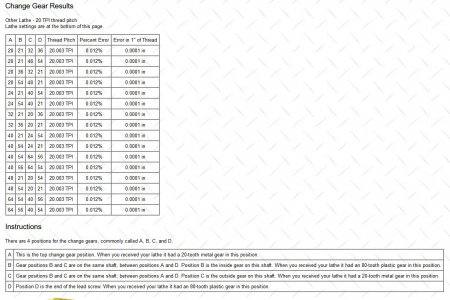- Joined
- Dec 18, 2019
- Messages
- 6,447
Couple of thoughts, which may or may not be relevant.
Timing matters. By that I mean one needs to consistently hit the same point on the wheel to get good threads. It's a skill which is best developed at slow speeds. Coarse threads spin the dial faster, and are harder to get consistently. The picture I posted above was by using the half nuts in the ordinary way - using the half nuts and hitting the mark every pass. I practice just using #1 on the dial.
If this is an older lathe, check the condition of the lead screw, is it worn? It is an acme thread, so it should have a nice square top all along the thread. Are your half nuts in good condition? Are they worn?
You seem to be addressing the cutter. That's good. Can you show a well lit picture that is in focus of the tool you were using? So we can see the grinding marks? As if you were holding the bit up close? We don't know if it was ground correctly, or the edges are in good shape.
Another question, how deep are your cuts when you are threading? Please provide a few numbers, just trying to get a sense of what you have been trying. Threading usually takes quite a few passes, so each pass isn't that deep. (That's the way I do it, and it seems to work.) Deepest cuts are ~0.005", tapering off to 0.001" as the thread gets to full depth.
Timing matters. By that I mean one needs to consistently hit the same point on the wheel to get good threads. It's a skill which is best developed at slow speeds. Coarse threads spin the dial faster, and are harder to get consistently. The picture I posted above was by using the half nuts in the ordinary way - using the half nuts and hitting the mark every pass. I practice just using #1 on the dial.
If this is an older lathe, check the condition of the lead screw, is it worn? It is an acme thread, so it should have a nice square top all along the thread. Are your half nuts in good condition? Are they worn?
You seem to be addressing the cutter. That's good. Can you show a well lit picture that is in focus of the tool you were using? So we can see the grinding marks? As if you were holding the bit up close? We don't know if it was ground correctly, or the edges are in good shape.
Another question, how deep are your cuts when you are threading? Please provide a few numbers, just trying to get a sense of what you have been trying. Threading usually takes quite a few passes, so each pass isn't that deep. (That's the way I do it, and it seems to work.) Deepest cuts are ~0.005", tapering off to 0.001" as the thread gets to full depth.


